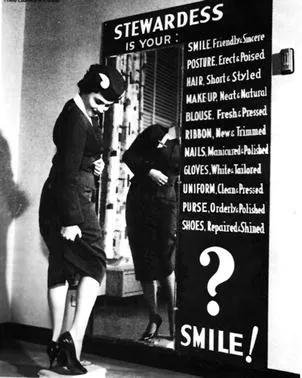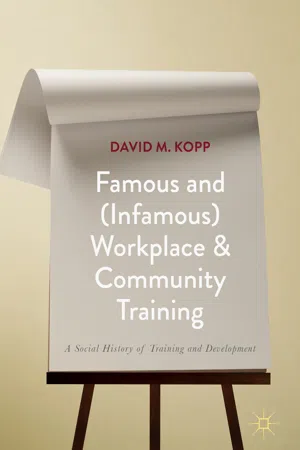Recently, I watched a job training video produced by the organization APAC. The 14-minute-plus orientation video not only detailed what a new worker could expect on the job, but also offered advice on topics such as how to manage finances, job safety, and performance improvement. Indeed, as a training professional and academic, I thought it was a well-done, first-rate piece of asynchronous training; however, what makes this training—parsimoniously defined here as activities that engender new behaviors—notable is not the training method itself, but the context of said training: APAC is the acronym for the Adult Performer Advocacy Committee and their training video 1 is entitled, Porn 101.
That the pornography industry would even have a
traditional employment training video is an example of the counterintuitive collocations that this book explores, that is, typical training juxtaposed against atypical context and vice versa. Broadly speaking, this book examines how the
ordinary was situated within the
extraordinary 2 and, while this book is not the first to explore such a dynamic,
3 it is sui generis in considering how common community-based and/or workplace training systems were linked to certain events or eras by contextualizing them as part of a social history of training.
By exploring a social history of training in situ within its socio-cultural context , we can also better position ourselves to reflect upon another theme I proffer, specifically, one that considers the axiology of training : is training amoral? Indeed, similar to the concept of truth, there is also no capital T in training; in other words, the construct of training, like with food, water, and oxygen, is—prima facie—value neutral until placed into a context.
As learning is often held within a specific setting (Tessmer & Richey, 1997), I take the position that, often times, training systems were, in practice, the means to facilitate the ends of what might be stratified as the good, the bad, and the dubious of society. So, for example, the value neutral training propositions of “properly utilizing an individual’s unused capabilities,” and “using small ratios of trainees to trainers” seamlessly transmogrify to bad training after we learn that these are excerpted from the al Qaeda training manual (U.S. Department of Justice, 2000, pp. 15, 47). And, in the same way, we may consider the good training used by the not-for-profit Dress for Success organization that empowers women by training them on life skills such as interviewing techniques and résumé writing so as to promote economic independence and self-sufficiency (Dress for Success, 2006).
By anthropomorphizing training —treating training itself as one of the human participants—and then ascribing subjective morality to it, we can more effectively step back and reflect on training’s fitness and virtue within a social context. This tests Waytz, Epley, and Cacioppo’s (2010) assertion that when something is anthropomorphized, it renders it worthy of moral care and consideration and, for our purposes, it allows us to better understand not only the processes of the training, but so, too, the goals.
For example, consider a thought experiment where training is a scoundrel, aiding and abetting sexism and the
objectification of women as deliberately
4 memorialized in the Hooters™ restaurant’s training handbook with its directives to the female servers:
Look wholesome, yet sexy … and, white bras only with make-up to be worn at all times. Approved shorts are to be tight-fitting also but should fit so that the buttocks of the server are not showing … jewelry and body piercings are to be subtle, yet sexy. (Hooters, 1999, 2007, pp. 5–6)
Consider, too, training as the plotting facilitator of fervid
fundamentalism movements as documented in the
Irish Republican Army’s (IRAs) training booklet (Irish Republican Army & Army,
1996) with its goal to unify all of Ireland by overthrowing British rule of Northern Ireland, or, as will be discussed, in the
Hitler Youth training manual (Brennecke, Childs, & Dodd,
1938) where there were not only tips for recalling the working parts of a rifle and the correct way to perform flag-based semaphore, but also training that supported the narratives of
social Darwinism and
eugenics, the study of improving the qualities of the (Aryan) population by discouraging reproduction by persons having genetic defects or undesirable traits (e.g., Jews) (Childs & Brennecke,
2007).
However, one must take care when anthropomorphizing historical training as there is a risk of waxing too nostalgic. That is, it could be tempting to view even dysfunctional training, by way of training manuals or films from by-gone eras, with a certain amount of fondness; in fact, cultural historian Ron Robin warns, “final documents are often eulogies rather than autopsies” (Robin, 1995, p. 12). On the other hand, we, too, must be mindful not to hold harmless the actual human actors who carried out dysfunctional training solely because of a theoretical claim that there be no judgment as they were just following the instructions of a training manual (ala, The Banality of Evil, Arendt, 1963). Thus, while we can anthropomorphize these artifacts, we must remember that the training was created by humans for humans, so the training manual could be viewed as an actual proxy for the human trainer; as a result, we may evaluate the performance of artifacts in reflecting on past behavioral systems because the person/object boundaries are blurred (Gilchrist, 2012; Schiffer, 2002). To be sure, the historical record has documented training systems ’ active role in human events both in triumph and ignominy; this can be both gratifying and anxiety-provoking.
Finally, as a tertiary theme , this book explores historical examples of community-based and workplace training systems from a critical theory perspective. That is to say, I keep in mind the underlying contexts, assumptions, and frameworks of training programs from particular worldviews guided by the social, economic, and political systems in place at the time (Ritchie, Lewis, Lewis, Nicholls, & Ormston, 2013). By doing this, we are able to question that status quo and “give voice” to aspects of injustices, inherent power differentials, or oppressions that may have existed at that time. Marcuse described this as the dialectic of liberation and domination (Marcuse, 1971), and it is what Gaventa (1982) referred to as the roles of power and powerlessness.
We can also glean the norms of the day that may be hidden within text using a critical hermeneutics and semiotics approach. So, for example, in the training manual
How to be a flight stewardess; a handbook and training manual for airline hostesses [emphasis added] (Smith,
1966),
5 we quickly pick up on the not-so-veiled point that in the 1960s and 1970s it was understood that flight attendants were female, and females were flight attendants [not pilots].
The essays presented in this book were chosen for their instrumentality. That is, as instrumental cases they can provide the reader insight into not only the specific proposition—the social history of training —but also facilitate an understanding of the larger issues the cases themselves may present (Yin, 2013). The review of the training and...



